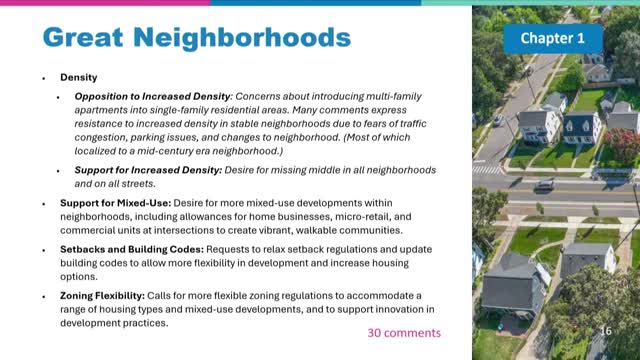City debates bold housing density changes amid mixed reactions
September 26, 2024 | Grand Rapids City, Kent County, Michigan
This article was created by AI summarizing key points discussed. AI makes mistakes, so for full details and context, please refer to the video of the full meeting. Please report any errors so we can fix them. Report an error »

In a recent government meeting, officials discussed community feedback regarding proposed changes to zoning regulations and density in residential neighborhoods. The meeting revealed a divided public opinion on increasing density, particularly concerning the introduction of multifamily apartments into traditionally single-family areas. Many residents expressed concerns about potential congestion, parking issues, and alterations to the character of what they termed \"stable neighborhoods.\"
Conversely, there was notable support for increased density, especially regarding \"missing middle\" housing types and mixed-use developments. Participants advocated for more flexible zoning regulations to accommodate diverse housing options and promote innovation in development practices. This sentiment was echoed in calls for updated codes that would allow for greater flexibility in setbacks, which are currently seen as restrictive for smaller parcels of land.
The discussion also highlighted a significant proposal to allow up to fourplexes in all residentially zoned neighborhoods, a move characterized as a bold policy change aimed at expanding housing types across the city. However, officials acknowledged the need for careful consideration of public feedback as they move toward implementation.
In addition to housing density, the meeting addressed comments on parking regulations. There was a split in opinions regarding the elimination of minimum parking requirements, with some advocating for their removal to support sustainable development, while others raised concerns about the potential impact on business viability.
The meeting concluded with a commitment to enhance communication and enforcement of existing laws, particularly concerning pedestrian and bicycle safety. Officials noted the importance of maintaining and improving infrastructure to support alternative transportation options, including public transit and safe pathways for non-motorized users. Overall, the discussions underscored the community's desire for a balanced approach to development that considers both growth and the preservation of neighborhood character.
Conversely, there was notable support for increased density, especially regarding \"missing middle\" housing types and mixed-use developments. Participants advocated for more flexible zoning regulations to accommodate diverse housing options and promote innovation in development practices. This sentiment was echoed in calls for updated codes that would allow for greater flexibility in setbacks, which are currently seen as restrictive for smaller parcels of land.
The discussion also highlighted a significant proposal to allow up to fourplexes in all residentially zoned neighborhoods, a move characterized as a bold policy change aimed at expanding housing types across the city. However, officials acknowledged the need for careful consideration of public feedback as they move toward implementation.
In addition to housing density, the meeting addressed comments on parking regulations. There was a split in opinions regarding the elimination of minimum parking requirements, with some advocating for their removal to support sustainable development, while others raised concerns about the potential impact on business viability.
The meeting concluded with a commitment to enhance communication and enforcement of existing laws, particularly concerning pedestrian and bicycle safety. Officials noted the importance of maintaining and improving infrastructure to support alternative transportation options, including public transit and safe pathways for non-motorized users. Overall, the discussions underscored the community's desire for a balanced approach to development that considers both growth and the preservation of neighborhood character.
View full meeting
This article is based on a recent meeting—watch the full video and explore the complete transcript for deeper insights into the discussion.
View full meeting
